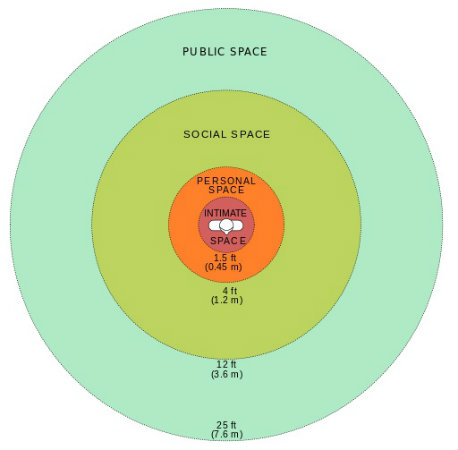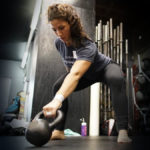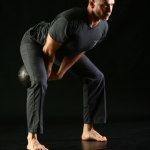We have all joked about our personal space. From a basic psychological perspective our personal space can be defined as:
“[T]he area surrounding an individual that is perceived as private by the individual, who may regard a movement into the space by another person as intrusive. Personal space boundaries vary somewhat in different cultures, but in general they are regarded as a distance of about 1 meter (3 feet) around the individual.” – Mosby’s Medical Dictionary, 9th edition
This concept of personal space is not new. As science journalist Natalie Wolchover wrote in a Discovery News psychology article, “According to American anthropologist Edward Hall, whose 1960s research on the topic still stands today, you’re actually enveloped by bubbles of four different sizes, each of which applies to a different set of potential interlopers.”
What are these four bubbles or zones? Wolchover went on to explain:
“The smallest zone, called “intimate space,” extends outward from our bodies 18 inches in every direction, and only family, pets and one’s closest friends may enter. A mere acquaintance hanging out in our intimate space gives us the heebie-jeebies. Next in size is the bubble Hall called “personal space,” extending from 1.5 feet to 4 feet away. Friends and acquaintances can comfortably occupy this zone, especially during informal conversations, but strangers are strictly forbidden. Extending from 4 to 12 feet away from us is social space, in which people feel comfortable conducting routine social interactions with new acquaintances or total strangers. Beyond that is public space, open to all.”
Now these bubbles as described by Edward Hall are more specific to Americans and there can be large cultural differences in personal space. As you saw, Mosby’s Medical Dictionary defines personal space as being one meter, or three feet. In the end personal space is, well, personal.
I’m sure at this point you are wondering what in the world this has to do with snatching a kettlebell? So, let’s use the concept of personal space to assist us in enhancing our technique in snatching a kettlebell.
Personal Space vs. Intimate Space: Swing vs. Snatch
The hip action of the snatch is the same hip action described in my previous article: The Perfect Kettlebell Swing: Is There Such a Thing. Based off of the deadlift, this hip hinge provides the ballistic action that propels the kettlebell. But that is where the similarities of the swing and snatch end.
Once the ballistic “pop” of the hip hinge has provided the energy to the kettlebell, it is up to the person performing the snatch to direct that energy so the kettlebell ends up overhead not projected away from the body at arm’s length as in the swing.
My arm length is about thirty inches or so. Congratulations, you may be thinking, but there is a point. And that is that swinging a kettlebell is a personal space activity. Meaning the kettlebell is projected away from me thirty-plus inches, going beyond my intimate space and out into my personal space (that 1.5- to 4-foot bubble). However, if I want to snatch the kettlebell, I should guide the energy of my ballistic hip pop to bring the kettlebell as close to my intimate space as possible.
Visualize bringing the kettlebell as close to that 1.5-foot intimate space bubble as possible on the way up. Don’t overthink it! Just guide the kettlebell as close to you as possible on a nearly straight arm and try to bring it inside your intimate space bubble on the way up and on the way down.
The more mathematically inclined of the group are wondering how I project my thirty-inch arm inside of the eighteen-inch intimate space. Well, in the swing we allow the arm to be “popped” off the ribs and our focus is on sending the energy of the swing out through the bottom of the kettlebell in a straight line. Like throwing a punch, I choose where the energy ends up. In the snatch, though, I keep the arm pit “closed” for much longer and direct the energy up toward the overhead lockout. This effectively “shortens” my arm and allows me to bring the kettlebell very close to my intimate space.
Watch the video to see a slow-motion demonstration of the “personal space” of the swing versus the “intimate space” of the snatch. Keep your eyes on the uprights of the rack.
Remember Your Overhead Lockout Technique
An important side note, the overhead lockout has two important aspects:
- The proper lockout is an easily achieved overhead position where the elbow is locked, the shoulder is not raised, and the bicep is in-line with but not touching the ear.
- The kettlebell in the lockout position is not held by the shoulder. It is held by the ground by efficiently aligning your structure so the weight of the kettlebell settles through the body to the ground.
The overhead lockout position is a pain-free and easily achieved position where the kettlebell is paused for a second (or more) before performing the next rep. If this is not the case for you, then you should focus on the swing and get help from an SFG on the technique and/or receive a movement screen and assistance from an FMS professional. (These can be the same person.)
Try Visualizing Intimate Space Next Time You Snatch
It is mentioned earlier that the visualization to keep the kettlebell as close to the personal space as possible applies to the way up and the way down. This is key to not getting the arm yanked by the kettlebell on its return to the bottom of the hip hinge.
If the kettlebell projects out into the personal space, it will turn over out away from the body and can pull the shoulder and person out of position (this can also be described as not controlling the dance of the center of mass as described in another article). Guide the kettlebell down through the intimate space so it is caught smoothly by the hips and can be redirected into the next rep efficiently.
Try the visualization of intimate space for the kettlebell snatch and see if is assists you in refining your technique.








